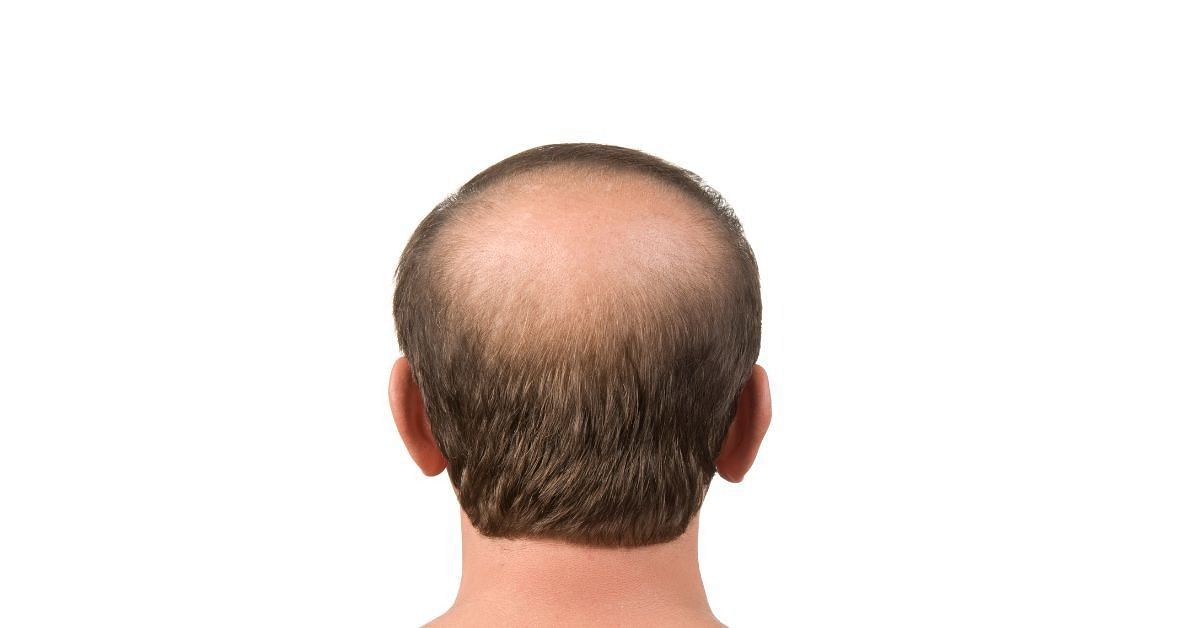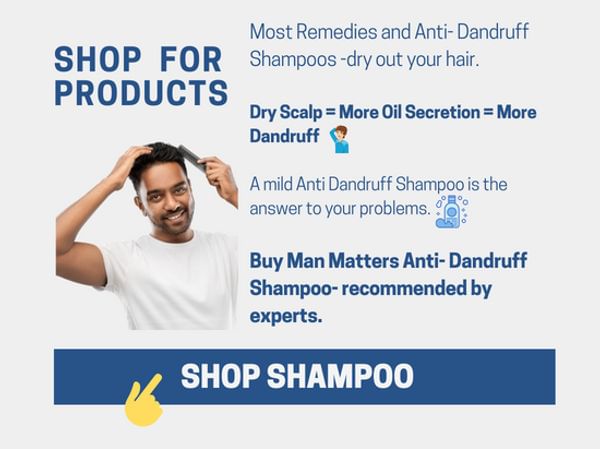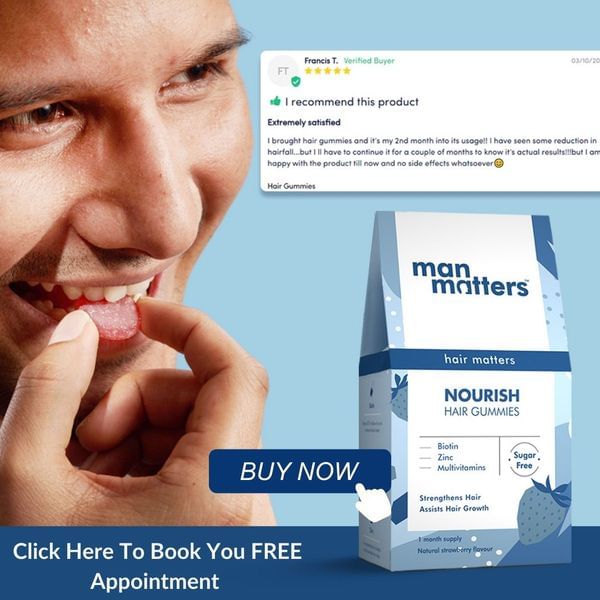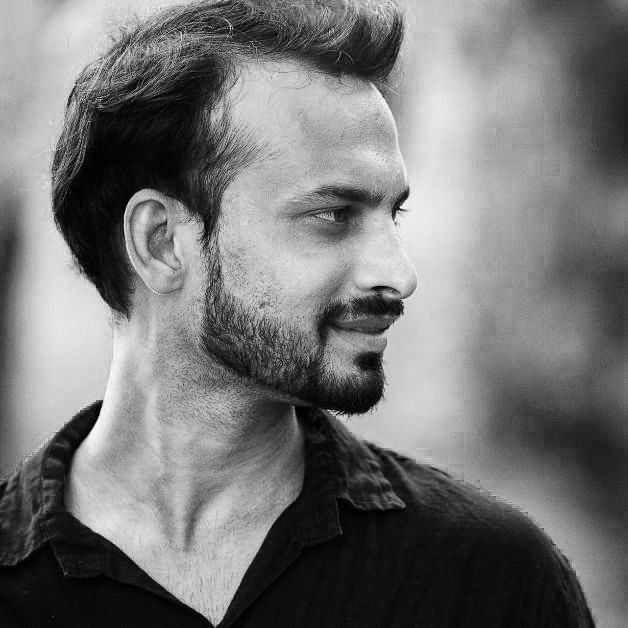How to Regrow Hair on a Bald Spot? 25 Science-Backed Methods to try!

Bald spots are characterised by hair loss at particular sites on the scalp, which can eventually lead to complete hair loss. While many factors can trigger it, it does not change the fact that the affected person can feel embarrassed, frustrated, and less confident. But, the good news is you can regrow hair on bald patches.
Here’s all you need to know about how to grow hair on bald spots using natural treatments, over-the-counter medications, and surgical procedures. Also, learn how to cope with baldness.

Natural Treatments for a Bald Spot
Men can regrow hair naturally by improving the blood circulation on the scalp. It will provide necessary nutrients to the roots and promote hair growth. It also restores hair quality and health. Here’s how to regrow hair on bald spots using these easily available products associated with hair growth:
1. Scalp Massage
Press your fingers against the scalp and massage the scalp regularly for five minutes to boost blood circulation. Massaging the scalp promotes thicker hair growth. You can use the following hair oil to regrow hair on bald spots:
- Castor Oil: You can warm castor oil and massage it on the scalp. Studies have suggested that it stimulates hair roots by improving blood circulation throughout the scalp. Also, its anti-fungal and anti-inflammatory properties reduce hair loss and dandruff.
- Peppermint Oil: As per a study, peppermint oil has medicinal properties and is also effective in boosting hair growth.
- Coconut Oil: Studies have shown that the antioxidants in coconut oil protect hair and scalp from damage. Also, a chemical component called alpha-tocopherol and the nourishing fats in the oil rejuvenate the scalp. This, in turn, promotes hair growth and strengthens the hair follicles.
- Rosemary Oil: Gently rub a small amount of oil on the bald spot each night. It has anti-inflammatory properties that improve blood circulation.
- Jojoba Oil: As per a study, the anti-inflammatory properties and moisturising properties of jojoba oil are similar to the natural oil produced by the skin. It also promotes hair growth.
- Pumpkin Seed Oil: Studies suggest that the carotenes, tocopherols, and other nutrients present in the pumpkin seed oil reverses hair loss. It also helps treat male pattern baldness. You can apply it directly on the scalp or mix it with olive oil and leave it overnight.
- Olive Oil: Studies have shown that olive oil has a component called oleuropein that promotes hair growth. It also nourishes and moisturises the hair.
- Kalonji or Black Seed Oil: Studies suggest that black seed oil treats hair loss and bald spots. It also strengthens and regenerates hair follicles. You can mix it with olive oil or coconut oil for added benefits.
- Aloe Vera: As per a study, aloe vera has anti-inflammatory properties with minerals and enzymes essential for hair growth. It also helps prevent scalp disorders. You can massage it directly on the scalp or mix it with coconut milk.
2. Diet for Bald Spots
Studies show that sometimes, hair loss is due to insufficient dietary intake of nutrients that are essential for hair. When you adopt the following dietary changes, it will replenish the body’s nutrients and promote hair growth on bald spots.
- Eat citrus foods for vitamin C.
- Add meat, chicken, fish, pulses, and beans to your diet for protein.
- Eat green leafy vegetables, broccoli, and apricots for vitamin A.
- Incorporate milk, yoghurt, eggs, strawberries, oats, rice, and red peppers for healthy hair growth.
- Drink 8 to 9 litres of water daily.
- Avoid junk and processed food.

3. Hair Care Routine
The following hair care habits can reduce hair loss and prevent bald spots:
- Do not frequently comb your hair as it weakens the hair follicles.
- Avoid combing wet hair.
- Use a soft towel to pat dry hair.
- Do not scrub the scalp vigorously.
- Use normal or cold water to rinse your hair.
- Use chemical-free hair products.
- Avoid heating tools for hair styling.
- Keep the scalp clean and wash hair regularly.
Over-the-Counter Treatments for Bald Spots
Many over-the-counter products are available commercially that promise hair regrowth. Here’s how to regrow hair on bald spots using the following proven OTC treatment for bald spots:
1. Minoxidil
Studies suggest that it is the most widely used product to treat hair loss. Minoxidil is available in liquid or foam form. You can use 5% of minoxidil solution regularly on hair twice a day without a prescription, but for higher concentration, you need a doctor’s prescription.
Although it has shown effective results in hair regrowth, it can cause some side effects, including skin irritation or unwanted hair growth near the scalp. Also, its effects start to wear off with time, so you need to use it for a longer period.

2. Products with Collagen
Our body has collagen protein that is associated with hair growth and the thickening of the hair shaft. It is an important ingredient in shampoos, serums, and conditioners. You can check the ingredients when buying hair products and use collagen-based products. It is also commercially available in the form of supplements and injectables.
3. Vitamin and Mineral Supplements
The deficiency of certain vitamins and minerals is associated with hair loss. So taking the following vitamins and minerals or their supplement can improve hair growth:
- Vitamin A
- Biotin
- Vitamin C
- Vitamin D
- Vitamin E
- Zinc
- Iron
Consult the doctor before taking these supplements. Their high dose can put you at risk of developing health complications.
Medical Treatments for a Bald Spot
Even after trying natural treatment methods and over-the-counter hair growth products, if you don’t see much hair growth in your bald spot, consult a doctor. They will diagnose the reason behind the bald spot and any underlying health condition causing the problem.
The consulting doctor will ask about your family history and medical history. They may conduct the following tests:
- Pull Test: They will pull out a few hair strands to check how easily and how many strands came out.
- Blood Test: It is to check the underlying medical conditions that can cause bald spots.
- Scalp Biopsy: In this, the health administrator takes a few scalp cells and examines them in the lab to know the causes behind hair loss.
Once the diagnosis is made, the doctor will prescribe the medications and precautions on how to regrow hair on the bald spots. Here are some of the frequently prescribed medications:
- Corticosteroids: It is usually prescribed in liquid form so that one can directly apply corticosteroids to the scalp. It can regrow hair within a few months. Also, doctors may administer corticosteroid injections on the scalp patches with hair loss.
- Anthralin: It is applied directly on the scalp and is effective in stimulating hair growth on bald spots.
- Finasteride or Propecia: Studies have shown that finasteride is the most widely prescribed hair growth drug across the globe.
- Methotrexate: It is a powerful medicine that is usually prescribed only if the above-mentioned medications don’t work. It is sometimes given in conjugation with corticosteroids to regrow hair on bald spots. It can have serious side effects, such as increased heartbeat, bloody vomit, stomach pain, and skin rashes. So, it is best advised to follow the instructions given by the doctor.

Surgical Treatments for Bald Spots
If medical treatment is not effective, you can go for surgical procedures. Although it should be the last resort as the transplanted hair follicles may not necessarily always work or produce healthy hair for a long time. It is best to discuss with the consulting doctor and understand the outcome of surgical procedures.
Here’s how to regrow hair on bald spots using the following most common surgical treatment procedure advised by the doctor:
1. Laser Therapy
There is not much evidence to prove the effectiveness of laser therapy in regrowing hair in the bald spot. It is found that low-level lasers can stimulate blood circulation and hair regrowth in the follicles that become dormant. Also, its results are inconsistent, so it may or may not work for you.
2. Hair Transplant Surgery
It is the most common solution for permanent hair loss. The doctor will remove hair follicles from the back of the head and implant them on the bald spots. It can be done using the following two methods:
- FUT Method: In this surgical method, the consulting doctor will remove skin strips with hair follicles from healthy scalp sites. From the hair strip, the hair follicles are removed and transplanted at the bald spots.
- FUE Method: In this surgical method, the doctor will remove individual hair follicles from the healthy scalp site and transplant them to the bald spot. They are inserted through tiny incisions and later promote hair regrowth.

Home Remedies that Might Help
Here is the list of a few scientifically proven home remedies known to regrow hair on bald patches:
1. Coconut Oil and Camphor
As per a study, camphor improves blood circulation, aids in hair growth, and decreases dandruff when combined with coconut oil. Here is how to regrow hair on bald spots using coconut oil and camphor:
What do you need?
- 100 mL coconut oil
- Five camphor tablets
How to use it?
- Crush the camphor tablets
- Mix them with 100mL of coconut oil
- Apply the mixture to the bald spots at night
- Wash it off using a mild shampoo
- Use it three times a week
Tip: You can keep the mixture for a month in an airtight jar.
2. Onion Juice
Studies have shown that onion juice is effective in treating bald patches on the scalp. Also, honey has antibacterial properties that reduce dandruff and hair fall associated with it. Here is how to regrow hair on bald spots using onion juice:
What do you need?
- One small-sized onion
- One tablespoon of honey
- Cotton
How to use it?
- Grate and squeeze out the onion juice
- Add one tablespoon of honey to it
- Apply the mixture to the scalp using cotton balls
- Keep it for 20 to 30 minutes
- Wash it properly to remove the smell of onion from the scalp using a mild shampoo
- Repeat it two times a week
Tip: Some people experience allergy or contact dermatitis on applying onions to the scalp. It is best to do a patch test on the scalp before using it. Also, consult a doctor if you experience any itching or irritation on the scalp.
3. Fenugreek Seeds or Methi
Studies have shown that fenugreek seeds can treat low to moderate hair loss. Other studies have shown that its extracts can promote hair growth. Here is how to regrow hair on bald spots using fenugreek seeds:
What do you need?
- 2 to 4 tablespoons of fenugreek seeds
- Water
How to use it?
- Grind the fenugreek seeds
- Mix it with water and make a fine paste of medium consistency
- Apply it to the scalp
- Keep it for an hour
- Rinse it off using a mild shampoo
- Apply it once or twice a week
Tip: You can also use buttermilk instead of water.

4. Coffee
Studies have shown that caffeine present in coffee promotes the growth of new hair follicles. Here is how to regrow hair on bald spots using coffee powder:
What do you need?
- Two teaspoons of coffee powder
- One tablespoon of honey
- One tablespoon of olive oil
How to use it?
- Mix 2 teaspoons of coffee powder and one tablespoon of honey with one tablespoon of olive oil
- Make a fine paste of medium consistency
- Apply it to the scalp
- Keep it for 20-25 minutes
- Wash it off using a mild shampoo
- Apply it two times a week
5. Ginger
As per a study, ginger has components that stimulate blood circulation to the scalp. It helps in the regrowth of hair follicles. Here is how to regrow hair on bald spots using ginger:
What do you need?
- One to two inches of ginger
- Two tablespoons of olive oil
How to use it?
- Grate the ginger
- Soak it in olive oil for 10 minutes
- Apply it to the scalp
- Massage for 2 to 3 minutes
- Keep it for 30 minutes
- Rinse it using a mild shampoo
- Apply it two times a week for better results
Tip: You can also use coconut oil or jojoba oil instead of olive oil.
Causes of Bald Spot
Although baldness is age-related, sometimes it can affect even young people. It can be the result of many factors. Following are the most common causes of bald patches:
1. Hereditary Hair Loss
It is also known as Androgenetic alopecia, and it runs in families. In men, the condition is often known as male pattern baldness, in which hair starts receding near the temples and top of the head.
2. Alopecia Areata
It is an autoimmune disease in which our body’s immune system starts attacking hair follicles. It leads to patchy hair fall, primarily affecting scalp hair, eyebrows, eyelashes, and other body parts.
3. Scarring Alopecia
When burns, injuries, skin infections, or radiations cause bald spots on the scalp, it is scarring alopecia.
4. Toxic Alopecia
In this condition, severe hair loss occurs for a short duration because of certain medication or underlying medical conditions.
5. Scalp Infections
It causes inflammation in the scalp leading to patchy hair loss at the inflamed sites. Once the infection subsides, hair tends to regrow at the bald spots.
6. Nutrient Indeficiency
The deficiency of biotin, iron, zinc, protein, and vitamins can cause bald spots and hair loss.
7. Stress
It can lead to hair loss, in which hair growth returns when the stress eases.
8. Medications
Certain medications such as acne medications, antibiotics, mood stabilisers, steroids, thyroid medications, and drugs that suppress the immune system can cause bald patches.
9. Cancer Treatment
It involves chemotherapy and radiation therapy that lead to complete hair loss within a few weeks. Hair may grow back when the treatment ends.
10. Hair Products and Styling
Hairstyles where you pull back your hair tightly, such as ponytails, can lead to bald spots. Also, some hair products contain chemical ingredients such as sodium lauryl sulphate or propylene glycol that can cause bald spots.

How Can I Cope With a Bald Spot?
A bald spot in your 20s or 30s can be alarming. Accept the situation and address it to prevent it from affecting your self-esteem and confidence. More than 5 million people in the US have bald spots, with over 70% of men experiencing male pattern baldness to some degree. It is natural and also treatable. It would be best if you considered the following tips to deal with the emotional trauma you face due to hair loss:
- You can always use hair extensions, wigs, hats, or scarves to make the most of the hair you have.
- Talk to your family and friends about how you feel.
- Consult the hair doctor as early as possible to slow down hair loss.
Summing Up
The bald spot is patchy hair loss triggered by age, genetics, lifestyle choices, nutritional deficiencies, or underlying scalp condition. The lost hair can be regrown by massaging the scalp with kalonji oil, coconut oil, or jojoba oil. You can also adopt a healthy diet, hair care routine, and exercise to promote healthy hair growth. Even after trying these methods, consult a doctor and take medications or surgical treatment based on their advice.
References
Poonkiat Suchonwanit, Minoxidil and its use in hair disorders: a review - https://www.ncbi.nlm.nih.gov/pmc/articles/PMC6691938/
Sudhir P Sawarkar, Nigella sativa seed, a novel beauty care ingredient: A review - https://www.researchgate.net/publication/315474605
Tao Tong, Topical Application of Oleuropein Induces Anagen Hair Growth in Telogen Mouse Skin - https://www.ncbi.nlm.nih.gov/pmc/articles/PMC4462586/
N Pazyar, Jojoba in dermatology: a succinct review - https://pubmed.ncbi.nlm.nih.gov/24442052/
E.B.C. Lima, Cocos nucifera (L.) (Arecaceae): A phytochemical and pharmacological review - https://www.ncbi.nlm.nih.gov/pmc/articles/PMC4671521/
Ji Young Oh, Peppermint Oil Promotes Hair Growth without Toxic Signs - https://www.ncbi.nlm.nih.gov/pmc/articles/PMC4289931/
Abdel Naser Zaid, Ethnopharmacological survey of home remedies used for treatment of hair and scalp and their methods of preparation in the West Bank-Palestine - https://www.ncbi.nlm.nih.gov/pmc/articles/PMC5499037/

